Giant Silkworm Moths
ENTFACT-701: Giant Silkworm Moths | Download PDF
by Ric Bessin, Extension Entomologist
University of Kentucky College of Agriculture
The royal or regal moths and the giant silk moths belong to the family Saturniidae. Most members of this faintly are large moths, the cecropia being the largest moth in North America. Because of their large size and sometimes striking colors and shapes, they attract a lot of attention when they are encountered, even among people who have no special interest in entomology. Also because the moths are rarely abundant, they are hardly ever taken for granted when one announces its presence by fluttering against a window at night.
The caterpillar stages of these moths are also large and spectacular and are observed more often than the moths. Some are ornamented with spines and barbed horns which makes them seem likely candidates for roles in horror movies. For the most part, this horrendous appearance is all show as far as harm to humans is concerned. However, the spines on the io moth caterpillar are true defensive weapons and can produce a painful sting to anyone who carelessly handles them.
Most of the saturniid caterpillar species feed on a wide variety of trees and shrubs, but have a preference for certain plants. One or two of the larger types of caterpillars can cause severe defoliation. Hand picking these caterpillars is sufficient control, but wear gloves if it is an io. Some of the smaller species of royal moths caterpillars feed in colonies and do more damage than the less numerous larger types of caterpillars. For these caterpillars, as well as large caterpillars out of reach in a tree, insecticide sprays may be needed to prevent further tree damage.
Cecropia Moth (Hyalophora cecropia)
This is the largest of the North American moths with a wing spread of five to seven inches. Its overall color is various shades of brown, but there is a conspicuous white mark near the center of each wing. There is a dark eye spot and a tinge of lavender near the tip of the front wing. The moths make their seasonal appearance in early summer and lay their eggs. They are often found at lighted windows at night.
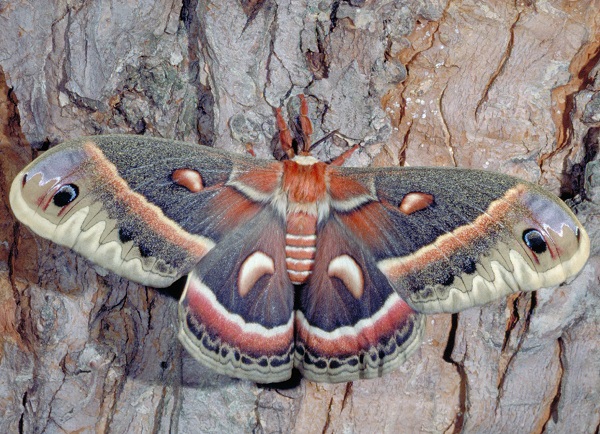
Figure 1. Cecropia Moth
The caterpillars take most of the summer to mature and are up to four inches long when fully developed. They are bluish green, and along the back there is a pair of yellow projections on each body segment. The first three pairs of tubercles are more conspicuous and are in the form of yellow balls with black spines. The cecropia caterpillars feed mainly on cherry, plum, apple, elderberry, box elder, maple, birch and willow, but will also feed on linden, elm, sassafras and lilac.
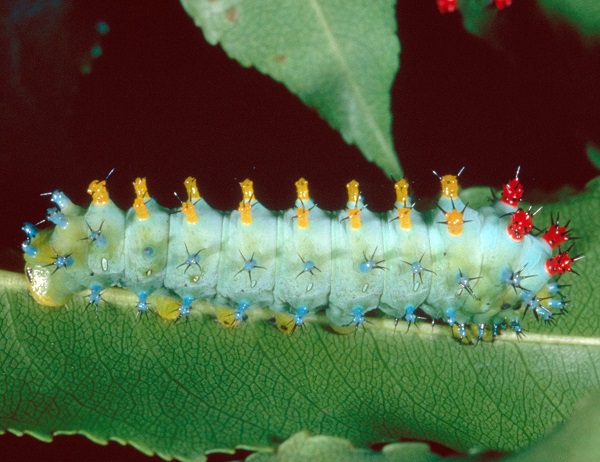
Figure 2. Cecropia moth caterpillar.
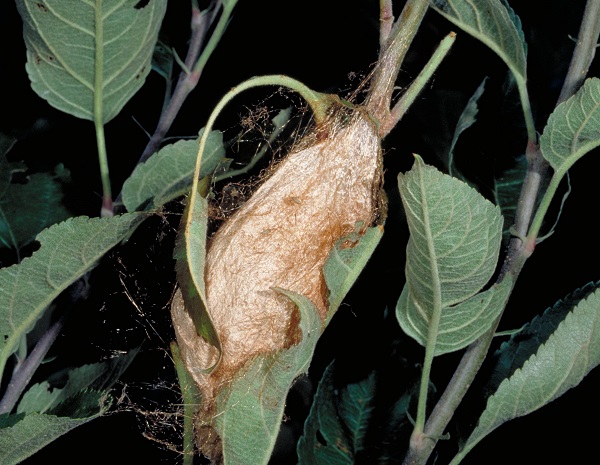
Figure 3. Cecropia moth cocoon.
In early fall the mature caterpillar spines a spindle-shaped cocoon which is about three inches long. The cocoon is attached along its full length to a twig on the host tree. Inside the cocoon the caterpillar changes to a pupa, the life stage in which it spends the winter.
Polyphemus Moth (Antheraea polyphemus)
This light brown or fawn colored moth has a wing span of 3.5 to 5.5 inches. Except for the eye-spots, it is less distinctly patterned than either the cecropia or promethea. There is a relatively small window-like spot near the middle of each wing, but the window of the hindwing is surrounded by a dark patch which makes it appear larger.
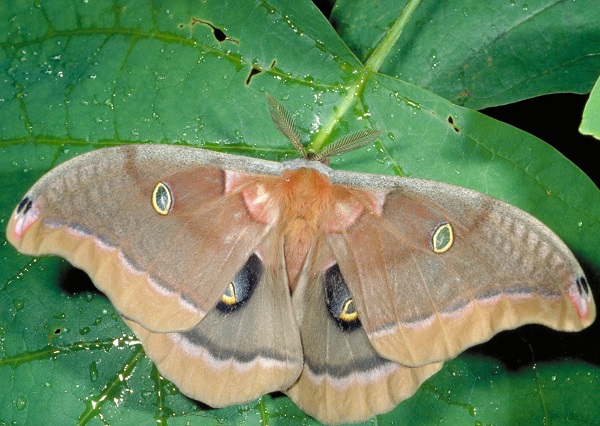
Figure 4. Polyphemus moth.
The polyphemus caterpillar prefers oak, hickory, elm, maple and birch but apple, beech, ash, willow, linden, rose, grape and pine are also satisfactory host plants. The caterpillar's color is light green with narrow white bars on the sides.
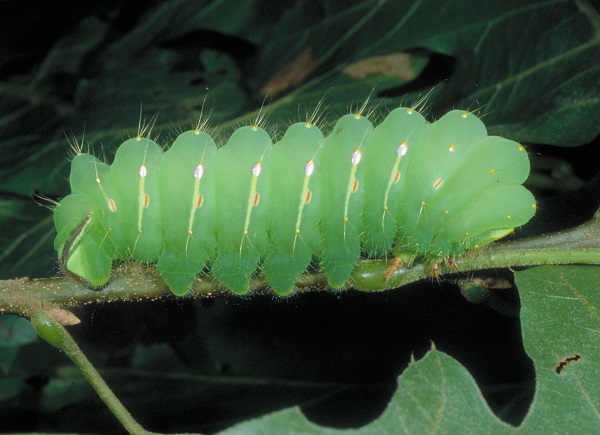
Figure 5. Polyphemus moth caterpillar.
They are stocky and slightly thicker in the middle. Caterpillars reach their full-grown length of a little less than four inches by August or September. At this time it spins an oval tough cocoon usually with a leaf of the host plant securely webbed to its surface.
The caterpillar changes to a pupa in the completed cocoon and spends the winter in this stage. The moths emerge from their cocoons and lay eggs the following June.
Promethea Moth (Callosamia promethea)
This moth has a wing spread of 2.5 to four inches, the females averaging a little larger than the males. The female promethea resembles the cecropia to some extent although it is much smaller. Both have an eye spot near the tip of the front wing and a white mark near the middle of each wing. However, the female promethea is a richer red-brown than the cecropia; the male promethea is dark brown to nearly black and lacks the white marks. The male also has the unusual habit, for a saturniid, of flying in the late afternoon. The rest of the saturniids are only active after dark.
Promethea caterpillars develop to their full two inches length by late summer or early fall. They are not as conspicuously adorned as some of the other saturniids, but they do have two short red pegs on the second and third body segments and a single yellow peg on the next to last body segment.

Figure 6. Promethea moth caterpillar
Tulip trees seem to be a favorite host plant but they will also feed on ash, azalea, bayberry, barberry, birch, button bush, cherry, lilac, plum, poplar, sassafras, spice bush and sweet gum.
Full-grown caterpillars spin a cocoon within a rolled leaf and change to the pupal stage. The petiole of the rolled leaf, covered with a layer of silk, forms a strap by which the cocoon hangs from a twig. These dangling cocoons are easily found on the bare trees in winter. Mature moths emerge from the cocoons and lay their eggs in June.
Luna Moth (Actias luna)
This large pale green, swallow-tailed moth with a clear window eyespot in the front and hind wings makes this one of the most beautiful saturniid moths, much prized by amateur collectors. The wing span is about four inches.
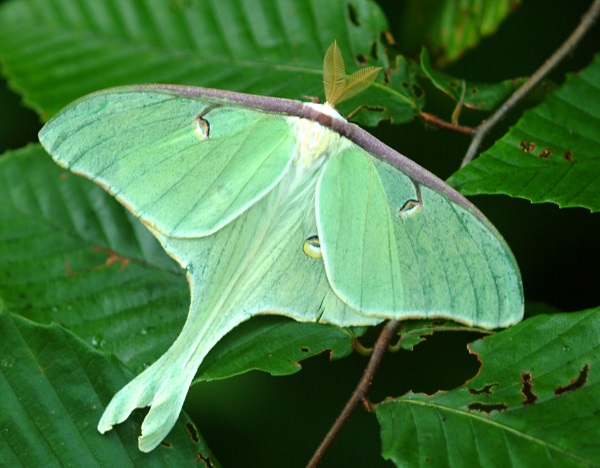
Figure 7. Luna moth.
The caterpillar is about three inches long and adorned with six rows of small pink tubercles out of which arise one or two black hairs. Neither the moth nor the caterpillar are collected very often. The caterpillar feeds mainly on sweet gum, hickory, walnut and persimmon, but has also been collected from sassafras, willow, oak, beech, plum and iron wood. The cocoon is spun among the leaves of the host and falls to the ground when the tree's leaves are shed. The adult moths emerge in June to lay eggs.

Figure 8. Luna moth caterpillar.
Io Moth (Automenis io)
This is not the smallest of the saturniid moths, but its wing spread of two to three inches is much less than that of average sized moths mentioned so far. The general color is yellowish with a large dark eye spot in the middle of each hind wing. The moths appearing in spring or early summer and can occasionally be found in fall.
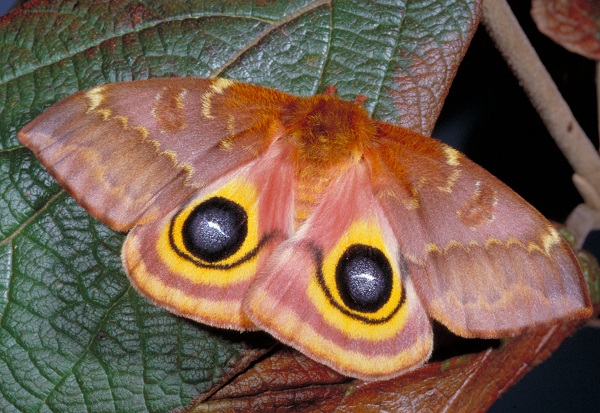
Figure 9. Io moth female.
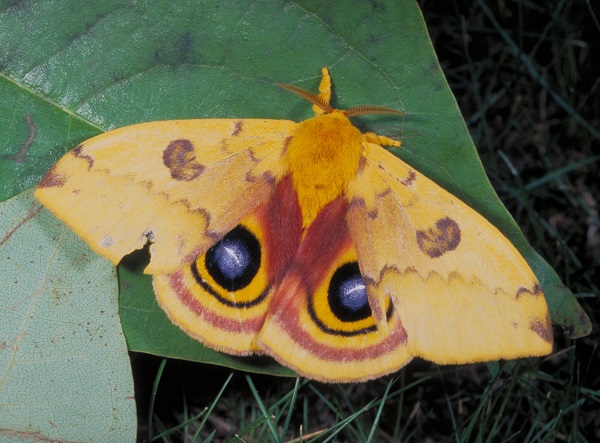
Figure 10. Io moth male.
The full-grown caterpillar is about two inches long and is thickly covered with branched black-pointed green spines. The spines can produce a painful sting to anyone who unwarily handles them.
The caterpillar is overall light green, but along each side there is a narrow lavender line bordered below with a white line. The caterpillars feed on a wide variety of plants including corn, roses, willow, linden, elm, oak, locust, apple, beech, ash, currant and clover.

Figure 11. Io moth caterpillar.
The pupa is about one inch long and formed within the protection of a few loosely webbed together leaves near the ground surface.
Royal Walnut Moth (Citheronia regalis)
The caterpillar of this moth is known as the hickory horned devil. These two common names identify the caterpillars' favorite host plant, however they will also feed on sumac, sweet gum, lilac, persimmon, ash and beech.
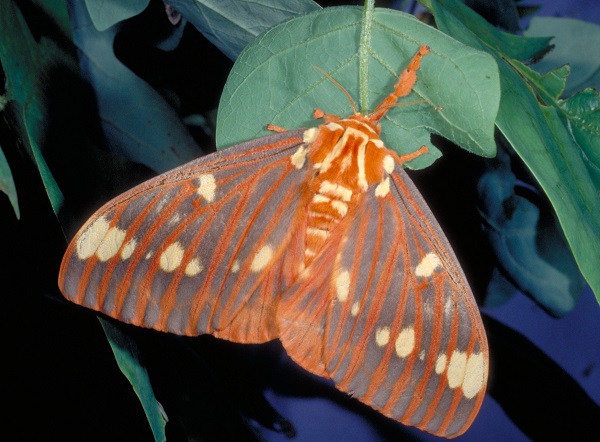
Figure 12. Royal walnut moth.
They are the largest of the silk moth caterpillars and commonly grow to five inches. The long barbed horns on the forward end of the body makes the caterpillar look intimidating but it is entirely harmless to humans.
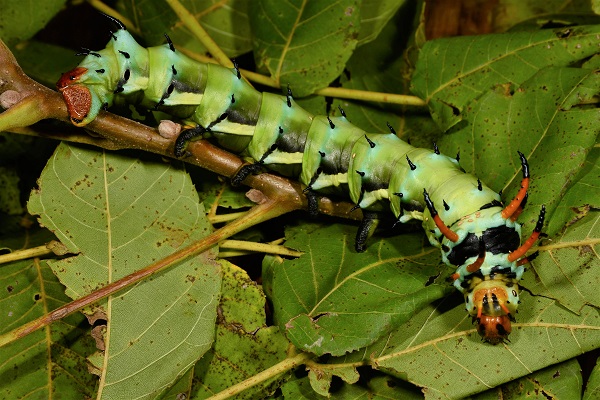
Figure 13. Hickory horned devil.
The full-grown larva may be still active in late September and October, and reportedly light frosts do not deter its feeding activities. Unlike typical saturniids, this caterpillar burrows into the ground to pupate. The moth emerges in late June to early July and has a wingspread of six inches. The front wings are gray-brown spotted with yellow and brown wing veins.
Imperial Moth (Eacles imperialis)
This is also a very attractive moth with a wingspread of four to 5.5 inches. Their general color is yellow marked with lilac patches, spots, lines and flecks. They are sexually dimorphic, the female being a little larger and more yellow. Some variation in markings also occur with locality, the more northern moths generally showing more yellow.

Figure 14. Imperial moth.
Fully developed caterpillars are three to four inches long and thinly clothed with long hairs. The barbed horns near the front of the body are much shorter than those of the hickory horned devil.
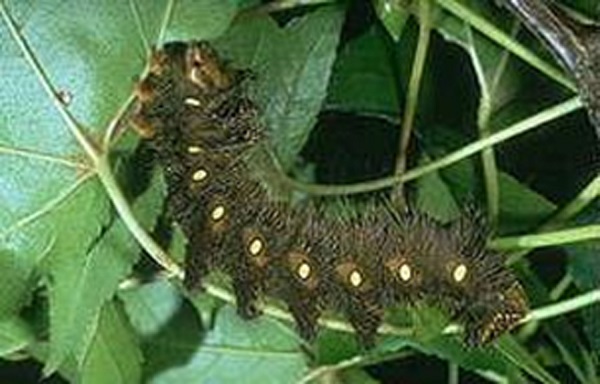
Figure 15. Imperial moth caterpillar.
Preferred host plants are oak, maple, pine, sycamore, sweet gum and sassafras. In Kentucky, imperial caterpillars prefer sassafras in the Knobs area, maple In northern Kentucky and pine in the Appalachian area. Other host plants include cypress, juniper, cedar, hemlock, spruce, sumac, alder, birch, horn beam, beech, elm, honey locust, linden, walnut and hickory.
The caterpillars mature in late September to early October and pupate in overwintering cells in the ground. The moths emerge in June and lay eggs.
Orangestriped Oakworm (Anisota senatoria)
This is a bright tan moth with a small white spot near the middle of the front wing. Males and females differ in appearance. The male is smaller, with a 1.5-inch wingspan, darker color and feathery antennae. The female has a 2.5-inch wingspan, is flecked with fine dark spots and does not have feathery antennae. They occur in Kentucky but are more common in states to the north.
Beginning in June and extending over a period of about a month the moths emerge and lay eggs. Caterpillars of all sizes are found during the summer but they all mature by early fall. Several similar species also occur in Kentucky but they are more distinguishable in the larva stage.

Figure 16. Orangestriped oakworm.
Full-grown caterpillars are about two inches long, black marked with eight yellow stripes and a row of large yellow spots just below the last lateral stripe. The underside of the body is also yellow. On the second segment behind the head are two long, slender, black horns, and along the body are smaller but conspicuous black spines. The caterpillars feed in groups, sometimes defoliating their host and migrating to another. Various species of oak are the preferred host plants, but hickory, maple and hazelnut are also attacked and raspberry and white birch have also been reported as hosts. In early fall the caterpillars move to the ground, burrow in three to four inches, change to pupae and spend the winter in this stage.
Greenstriped Mapleworm (Dryocamma rubicunda)
This is also known as the rosy maple moth and has a wingspread of 1.5 to two inches. The forewings are rose-red crossed by a broad pale yellow band. The body is yellow with the underside and legs rose-red.
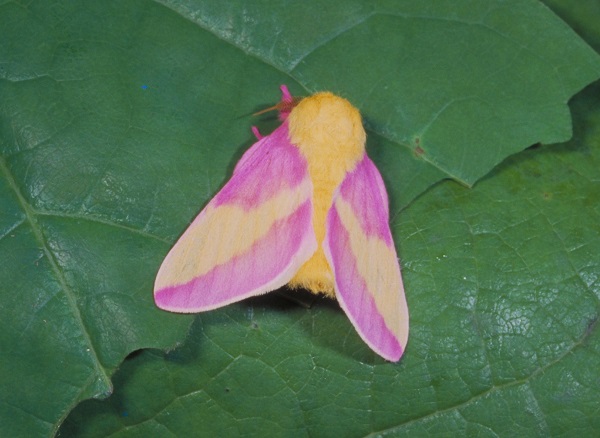
Figure 17. Rosy maple moth.
The male is slightly smaller than the female. The full-grown caterpillar is about 1.5 inches long, pale yellowish-green and striped with alternate pale yellow-green and darker green lines. The head is cherry red. On the second segment behind the head are two long, slender, slightly curved black horns. Short black spines occur along the sides of the body. On the lower side of the body near the rear is a rose-colored area. The preferred food is leaves of silver and red maples but they occasionally feed on box elder and oaks. Large colonies of caterpillars sometimes strip host trees in the mid-west.
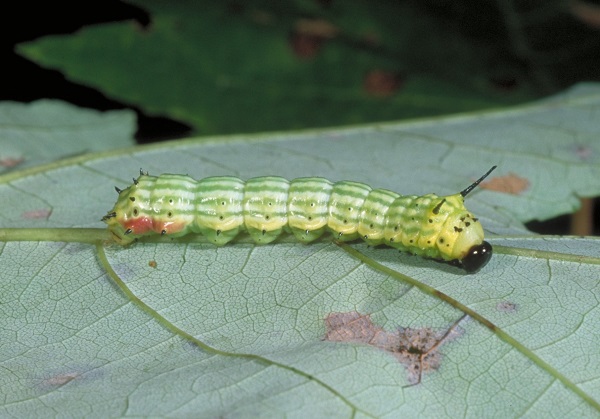
Figure 18. Greenstriped mapleworm.
Winter is spent in the soil as a dark brown, hard-shelled pupa slightly less than one inch long. The moths emerge in May and begin laying eggs on the underside of leaves. Each female lays about 150 eggs. Egg hatch in about eight to ten days, and the young caterpillars begin to feed.
In about a month, after molting four times, the caterpillars are full grown; they move to the ground and work their way into the leaf litter where they transform to pupae. A second brood of moths appear later in the season.
Spiny Oakworm (Anisota stigma)
In the moth stage this resembles the orange-striped oakworm, but is more densely flecked with dark spots. The orange-striped species is more prevalent to our north. The spiny oak worm seems to be more common in Kentucky.
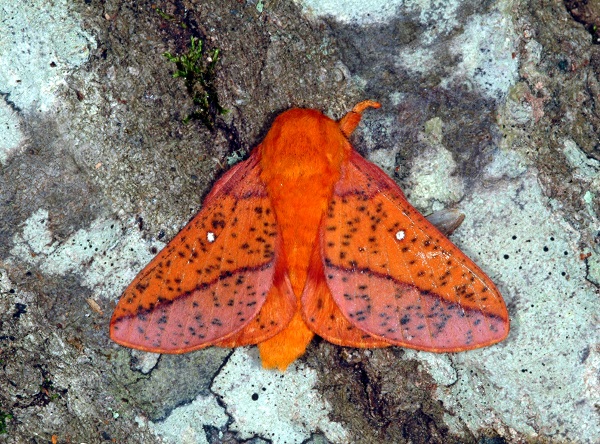
Figure 19. Spiny oakworm moth.
Caterpillars of the spiny oakworm resemble those of the orange striped oak worm and the green striped mapleworm in many respects except the stripes are inconspicuous and the darker stripes are speckled with tiny white dots.
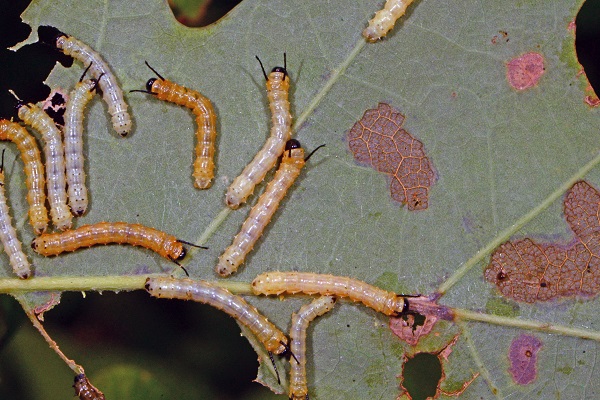
Figure 20. Spiny oakworm caterpillars.
The body spines are longer and slightly branched compared with the shorter spines on the other species. Oak is the main host plant.
Revised: 11/19
CAUTION! Pesticide recommendations in this publication are registered for use in Kentucky, USA ONLY! The use of some products may not be legal in your state or country. Please check with your local county agent or regulatory official before using any pesticide mentioned in this publication.
Of course, ALWAYS READ AND FOLLOW LABEL DIRECTIONS FOR SAFE USE OF ANY PESTICIDE!
Images:Ric Bessin, University of Kentucky Entomology
